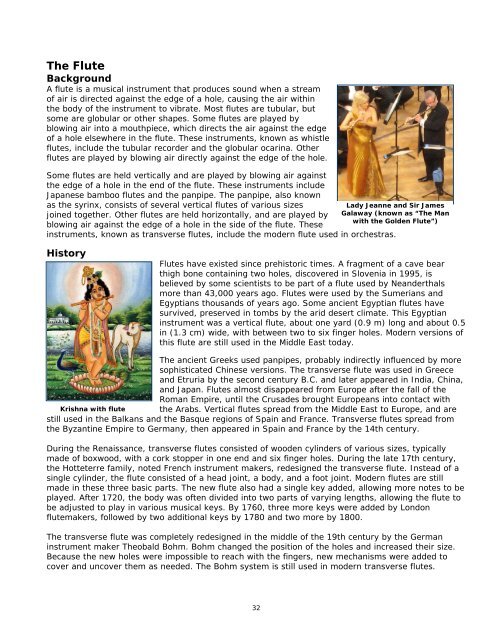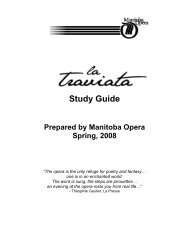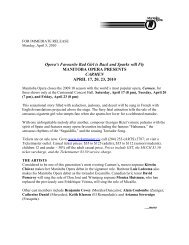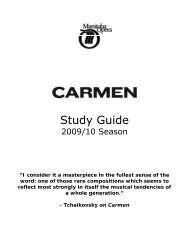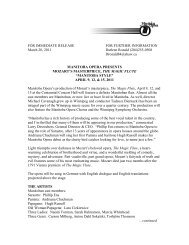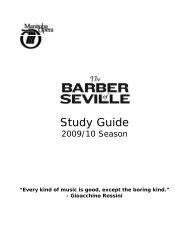The Magic Flute Study Guide - Manitoba Opera
The Magic Flute Study Guide - Manitoba Opera
The Magic Flute Study Guide - Manitoba Opera
Create successful ePaper yourself
Turn your PDF publications into a flip-book with our unique Google optimized e-Paper software.
<strong>The</strong> <strong>Flute</strong><br />
Background<br />
A flute is a musical instrument that produces sound when a stream<br />
of air is directed against the edge of a hole, causing the air within<br />
the body of the instrument to vibrate. Most flutes are tubular, but<br />
some are globular or other shapes. Some flutes are played by<br />
blowing air into a mouthpiece, which directs the air against the edge<br />
of a hole elsewhere in the flute. <strong>The</strong>se instruments, known as whistle<br />
flutes, include the tubular recorder and the globular ocarina. Other<br />
flutes are played by blowing air directly against the edge of the hole.<br />
Some flutes are held vertically and are played by blowing air against<br />
the edge of a hole in the end of the flute. <strong>The</strong>se instruments include<br />
Japanese bamboo flutes and the panpipe. <strong>The</strong> panpipe, also known<br />
as the syrinx, consists of several vertical flutes of various sizes<br />
joined together. Other flutes are held horizontally, and are played by<br />
blowing air against the edge of a hole in the side of the flute. <strong>The</strong>se<br />
instruments, known as transverse flutes, include the modern flute used in orchestras.<br />
History<br />
<strong>Flute</strong>s have existed since prehistoric times. A fragment of a cave bear<br />
thigh bone containing two holes, discovered in Slovenia in 1995, is<br />
believed by some scientists to be part of a flute used by Neanderthals<br />
more than 43,000 years ago. <strong>Flute</strong>s were used by the Sumerians and<br />
Egyptians thousands of years ago. Some ancient Egyptian flutes have<br />
survived, preserved in tombs by the arid desert climate. This Egyptian<br />
instrument was a vertical flute, about one yard (0.9 m) long and about 0.5<br />
in (1.3 cm) wide, with between two to six finger holes. Modern versions of<br />
this flute are still used in the Middle East today.<br />
<strong>The</strong> ancient Greeks used panpipes, probably indirectly influenced by more<br />
sophisticated Chinese versions. <strong>The</strong> transverse flute was used in Greece<br />
and Etruria by the second century B.C. and later appeared in India, China,<br />
and Japan. <strong>Flute</strong>s almost disappeared from Europe after the fall of the<br />
Roman Empire, until the Crusades brought Europeans into contact with<br />
Krishna with flute the Arabs. Vertical flutes spread from the Middle East to Europe, and are<br />
still used in the Balkans and the Basque regions of Spain and France. Transverse flutes spread from<br />
the Byzantine Empire to Germany, then appeared in Spain and France by the 14th century.<br />
During the Renaissance, transverse flutes consisted of wooden cylinders of various sizes, typically<br />
made of boxwood, with a cork stopper in one end and six finger holes. During the late 17th century,<br />
the Hotteterre family, noted French instrument makers, redesigned the transverse flute. Instead of a<br />
single cylinder, the flute consisted of a head joint, a body, and a foot joint. Modern flutes are still<br />
made in these three basic parts. <strong>The</strong> new flute also had a single key added, allowing more notes to be<br />
played. After 1720, the body was often divided into two parts of varying lengths, allowing the flute to<br />
be adjusted to play in various musical keys. By 1760, three more keys were added by London<br />
flutemakers, followed by two additional keys by 1780 and two more by 1800.<br />
<strong>The</strong> transverse flute was completely redesigned in the middle of the 19th century by the German<br />
instrument maker <strong>The</strong>obald Bohm. Bohm changed the position of the holes and increased their size.<br />
Because the new holes were impossible to reach with the fingers, new mechanisms were added to<br />
cover and uncover them as needed. <strong>The</strong> Bohm system is still used in modern transverse flutes.<br />
32<br />
Lady Jeanne and Sir James<br />
Galaway (known as “<strong>The</strong> Man<br />
with the Golden <strong>Flute</strong>”)


